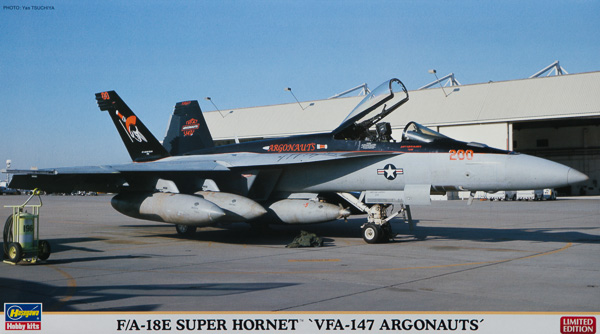
Hasegawa 1/72 F/A-18E Super Hornet "VFA-147 Argonauts"
By Chris Banyai-Riepl
Overview
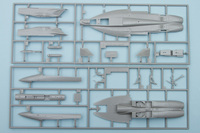 The F/A-18E is the evolution of the original Hornet, being larger and featuring more advanced avionics. It entered service in 1999, eventually replacing the F-14 Tomcat, which retired in 2006. Currently the Super Hornet operates with both the US Navy and, since 2010, the Royal Australian Air Force. In US Navy service, the Super Hornet is a popular canvas for colorful CAG schemes, which makes it a popular subject with modelers as well.
The F/A-18E is the evolution of the original Hornet, being larger and featuring more advanced avionics. It entered service in 1999, eventually replacing the F-14 Tomcat, which retired in 2006. Currently the Super Hornet operates with both the US Navy and, since 2010, the Royal Australian Air Force. In US Navy service, the Super Hornet is a popular canvas for colorful CAG schemes, which makes it a popular subject with modelers as well.
The Kit
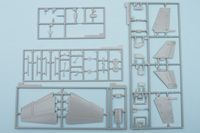 Hasegawa's Super Hornet remains the best choice in 1/72, and this recent release provides some colorful markings from VFA-147. The kit comes molded in light gray plastic and features recessed panel lines and a complex assembly. Given the shape of the F-18E, that complexity is unavoidable, and the way Hasegawa handles it is actually not too bad. The kit comes with some basic weaponry and two marking choices.
Hasegawa's Super Hornet remains the best choice in 1/72, and this recent release provides some colorful markings from VFA-147. The kit comes molded in light gray plastic and features recessed panel lines and a complex assembly. Given the shape of the F-18E, that complexity is unavoidable, and the way Hasegawa handles it is actually not too bad. The kit comes with some basic weaponry and two marking choices.
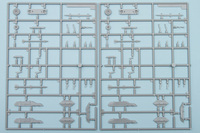 Construction begins with the cockpit, and like most of Hasegawa's newest 1/72 releases, this one features a simple cockpit tub with all the detail coming from decals. The seat is rudimentary as well, and would definitely benefit replacement with a highly detailed resin example. Out of the box, though, the cockpit is good enough for a closed canopy model. For those wanting to go a bit further, though, there are plenty of aftermarket photoetch and resin sets to really make this interior stand out.
Construction begins with the cockpit, and like most of Hasegawa's newest 1/72 releases, this one features a simple cockpit tub with all the detail coming from decals. The seat is rudimentary as well, and would definitely benefit replacement with a highly detailed resin example. Out of the box, though, the cockpit is good enough for a closed canopy model. For those wanting to go a bit further, though, there are plenty of aftermarket photoetch and resin sets to really make this interior stand out.
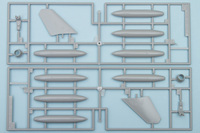 Once the cockpit is together, the challenging assembly begins. The fuselage is split up into five major pieces, with separate intakes providing an additional four pieces. The nose comes in right and left halves, with a separate lower nose insert, while the rear fuselage is split into upper and lower halves. For the most part, the breaks fall in logical places, but this is definitely a place where going slow will pay off. Additionally, the instructions indicate several areas where panel lines and antenna bumps need to be removed, so definitely pay attention to the instructions here.
Once the cockpit is together, the challenging assembly begins. The fuselage is split up into five major pieces, with separate intakes providing an additional four pieces. The nose comes in right and left halves, with a separate lower nose insert, while the rear fuselage is split into upper and lower halves. For the most part, the breaks fall in logical places, but this is definitely a place where going slow will pay off. Additionally, the instructions indicate several areas where panel lines and antenna bumps need to be removed, so definitely pay attention to the instructions here.
After some fiddling and finessing, you'll get the fuselage together and from there on out the assembly will be fairly straightforward. The wings are split into upper and lower halves and feature some large and positive locating pegs. The stabilizers are a bit different, as they have just a long peg. This is both good, in that you can position the stabilizer at any angle, but it is also a bit fragile so I would take care with that assembly.
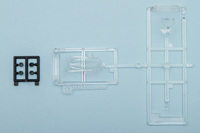 Moving on to the landing gear, this definitely captures the look of the beefy Navy landing gear. The nose gear strut is molded as one piece, with separate wheels and separate gear doors. The main gear has separate actuator struts and separate wheels. The main gear doors are also separate, as is the tailhook and all the flap & aileron actuators. While looking at the underside of the kit, the model comes with AIM-9X and AIM-120 missiles, as well as three fuel tanks and the AN/ASQ-228 ATFLIR for the intake side.
Moving on to the landing gear, this definitely captures the look of the beefy Navy landing gear. The nose gear strut is molded as one piece, with separate wheels and separate gear doors. The main gear has separate actuator struts and separate wheels. The main gear doors are also separate, as is the tailhook and all the flap & aileron actuators. While looking at the underside of the kit, the model comes with AIM-9X and AIM-120 missiles, as well as three fuel tanks and the AN/ASQ-228 ATFLIR for the intake side.
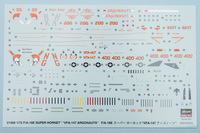 The decal choices are both for VFA-147 "Argonauts", and both are CAG aircraft. The more sedate one is from 2010 and it is finished in the overall TPS scheme, with just a bit of color in the tail markings and squadron markings. The CAG aircraft from 2011, though, is much more colorful, and is the subject of the boxtop photo. This aircraft has a black spine and black fins, with colorful orange and white markings. The decals are nicely printed and should be dense enough to cover thoroughly on the black portions.
The decal choices are both for VFA-147 "Argonauts", and both are CAG aircraft. The more sedate one is from 2010 and it is finished in the overall TPS scheme, with just a bit of color in the tail markings and squadron markings. The CAG aircraft from 2011, though, is much more colorful, and is the subject of the boxtop photo. This aircraft has a black spine and black fins, with colorful orange and white markings. The decals are nicely printed and should be dense enough to cover thoroughly on the black portions.
Conclusion
If you are looking to add a Super Hornet to your shelves, the Hasegawa kit will definitely fit the bill. While the cockpit is a bit basic, the kit overall is well detailed and with some care in assembly can result in a stunning model. My thanks to Hasegawa USA for the review sample.
